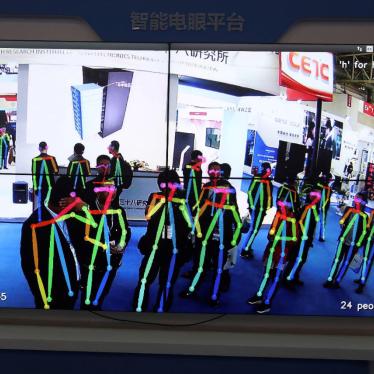Barely a day goes by without a story about China’s ambition to use new technologies for nefarious means, and Human Rights Watch has amassed evidence that President Xi Jinping is building a “digital totalitarian state.” But Beijing’s aspirations to control people’s everyday lives are not so easily realized. Supporters of human rights have plenty of opportunities to limit the damage.
The recent headlines are chilling: “In China, your car could be talking to the government.” “China’s brightest children are being recruited to develop AI ‘killer bots.’ ” The country’s “social credit” system restricts the freedoms of citizens the state considers to have behaved badly. The government is pushing for national DNA and voice-recognition databases and for big-data “predictive policing” programs aimed at picking out political threats—all without any effective protections for privacy. The brutal crackdown on Muslims in the northwestern Xinjiang region of China involves both high- and low-tech surveillance.
Yet the Chinese government’s mass-surveillance capabilities are more fearsome in theory than in practice. “While big data has become a sizzling hot concept, there is so much more speculation than actual application,” laments one researcher working for the Chinese police, who adds that police leaders are frustrated they may be “sitting on” a “data gold mine” that they are unable to exploit properly. Authorities’ mass-surveillance ambitions are bedeviled by unreliable and incomplete basic data, as well as incompatible datasets and systems developed by different companies, among other problems.
Plus, citizens across China find ingenious ways to evade surveillance. Blacklisted by the social-credit system? Use documents other than ID cards to get around the restrictions. Concerned your calls are being monitored? Activists have learned creative ways to make police lose track of them.
Beijing has devoted enormous efforts to perfecting mass surveillance during the “Strike Hard” crackdown in Xinjiang, which began in late 2016. One element—the “Becoming Family” program, in which officials are dispatched to live with Muslim families, monitor and indoctrinate them—requires mobilizing 1.1 million government officials to keep tabs on a population of 13 million Muslims.
These programs depend on meticulous data input, which may prove unsustainable. Local officials report logging grueling hours—early morning until midnight, with hardly any vacation—to maintain a constant stream of “dynamic” data necessary for mass surveillance and other repressive measures.
Communist officials’ laxness also hinders surveillance. One woman from Xinjiang told Human Rights Watch that while she was supposed to be under house arrest, the people assigned to watch her took photos of her engaged in various activities around her house—then left and went home. Her minders later sent the pictures to their superiors, pretending that the photos were taken on different days.
There’s no doubt that Chinese authorities are moving in an ominous direction—few things are more alarming than a powerful rights abuser with cutting-edge technology. But there’s still time to arrest or reverse these trends and stigmatize the use of technology for oppressive purposes.
To that end, governments and tech companies should begin by adhering to existing privacy protections, which are already established in international human-rights treaties. The U.S. and other governments must investigate and map out the ways in which mass-surveillance technology is being transferred to the Chinese authorities, particularly the police, and figure out how to restrict such transfers. Technology companies need to be held accountable for enabling the Chinese government’s abuses or advancing its surveillance goals.
The increasingly aggressive and abusive Chinese government poses a significant danger, but the free world should not be cowed. Governments, companies and civil society can translate legitimate fears into concrete efforts to contain Beijing’s dystopian ambitions.









